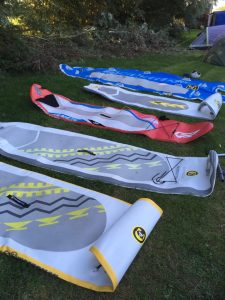Stand Up Paddleboarding – SUP
If your interested in Stand Up Paddleboarding then here is some useful info.
But if you want to know more info then contact:- Stewart Tedaldi. Contact details via http://www.nuttybadgers.org.uk/contact-us/
IT MAY LOOK EXOTIC AND WILD. But the born-in-Hawaii sport of stand-up paddling (SUP) is among the most accessible on-water activities you can try. It’s also one of the most fun — picture yourself gliding on water, each reaching paddle stroke propelling you faster as you fly across a glassy plane.
1. IT’S NOT AS HARD AS IT LOOKS. Balance is good. But you don’t need yogic concentration to stand up and paddle on a SUP board. The wide and uber-buoyant watercrafts are forgiving and stable. A first-timer can often become comfortable in an hour of instruction before heading out with a buddy boarder to explore open waters.
2. OCEANS, RIVERS, LAKES. SUP boards are agnostic to water-body type, and they work just as well in waves, mild river current, or on the flat water of a lake. Experts catch curling waves at ocean breaks. You and your Scouts can leisurely paddle on a calm lake or ocean harbor.
3. BIRD’S-EYE VIEW. OK, so maybe the view is more of a duck coming in for landing. But you get the picture. Unlike a canoe or kayak, the tall posture required in SUP gives higher visibility and a unique “walking on water” view.
4. VERSATILE GEAR. Scouts (or even adults) of all sizes can easily hop aboard a basic beginner stand-up paddleboard that’s between 10 and 12 feet long. Don’t have a floatation device designed specifically for SUP? Use a canoeing life jacket. Use a lightweight shirt for extra sun protection. Or, you can even wear a hydration pack (used for mountain biking, for example) as a way to hydrate while paddling.
5. FULL-BODY WORKOUT. Legs, abdominals, back, neck, and arms — almost all muscles are engaged when you reach and pull on a SUP board. The combination of balance and power required to make consistent strokes offers a workout about as “full body” as they come.
6. NATURAL BODY POSITION. You’re standing up. You’re reaching with straight arms, pulling back at the water, and engaging the arms and abs. As mentioned above, the workout in SUP can be immense and as comprehensive as you make it. But it’s also comfortable and natural, with no forced contortion or over-effort needed to break a sweat, burn calories, and get in shape fast.
7. GO ANYWHERE — ON WATER. Catch a wave for a rush. Glide quietly into a mangrove swamp in search of manatees or birds. Point a board out toward the center of a lake. The watery situations are almost limitless standing on the versatile back of a SUP board.
8. POWER STROKE. In general, a person can generate more power on a stand-up paddleboard than a seated kayaker. You reach and pull, engaging your whole body. This equals immense speed and efficiency on the water once you master the sport.
9. SIMPLE SETUP. A board, a paddle, and a PFD are the main items needed to SUP. There’s no rigging involved, no setup time, and very little gear required to get on a board and go. Compared to other water sports, there’s very little “hassle factor” in the world of SUP. Sounds great when you consider the challenges that come with wrangling a group of Scouts, no?
10. NO IMPACT. Like other paddle sports, SUP is sustainable and eco-friendly. There’s no gas required.
The Boy Scouts of America have a good guide to SUPing.
BSA Stand Up Paddleboarding Award




